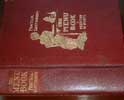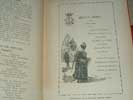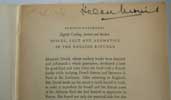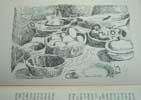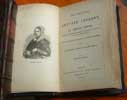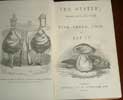Soyer's Culinary Campaign
BEING HISTORICAL REMINISCENCES OF THE LATE WAR. WITH THE PLAIN ART OF COOKERY FOR MILITARY AND CIVIL INSTITUTIONS, THE ARMY, NAVY, PUBLIC, ETC. ETC. By ALEXIS SOYER, AUTHOR OF "THE MODERN HOUSEWIFE" "SHILLING COOKERY FOR THE PEOPLE" ETC. LONDON: G.ROUTELEDGE & CO., FARRINGDON STREET. NEW YORK: 18, BEEKHAM STREET. 1857. {The right of translation is reserved.]
FIRST AND SOLE EDITION. 1857. 1fep. [1] Frontispiece of an aged Soyer. Title page. [1] 1pp Dedication to Lord Panmure. [1] 1pp Preface. [1] 2pp Contents. An illustrated drawing of Soyer by H.G.Hine. [1] 1-593. [1] 3pp Index to Addenda. 2pp Advertisements. 1fep. Frontispiece tipped in with a strip of contemporary paper without affecting Soyer's portrait. The title page very lightly browned with slight chipping to edges not affecting the text. The H.G. Hine illustration has some very light foxing. Overall clean inside. Original red cloth binding with gilt pictorial vignette. Red cloth binding has been sympathetically re-laid but with dull gilt lettering. Overall slightly rubbed with a 1"sq. ink stain on the back cover. Tipped in is a B&W newspaper photograph of the last picture of Florenece Nightingale in 1910, lying in a rather plush bed looking out of the window. Also a very nice detailed illustrated drawing cut out from a 19th century magazine of "M. Soyer's Hospital Kitchen, at Scutari Barracks" A very interesting volume and a scarce item.
- On 2 February 1855, Soyer wrote to The Times offering to go to the Crimea at his own expense to advise on the cooking for the army there. He began by revising the diet sheets for the hospitals at Scutari and Constantinople. In two visits to Balaklava he, Florence Nightingale and the medical staff reorganised the provisioning of the hospitals; he also began to cook for the fourth division of the army. On 3 May 1857 he returned to London, and on 18 March 1858 he lectured at the United Service Institution on cooking for the army and navy. He also built a model kitchen at the Wellington Barracks, London. He died on 5 August 1858 at St. John's Wood, London and was buried on 11 August in Kensal Green cemetery. Soyer wrote many other cookery books including: Délassements Culinaires. (1845) The Gastronomic Regenerator (1846) Soyer's Charitable Cookery (1847) The Poorman's Regenerator (1848) The Modern Housewife of Menagere (1850) The Pantropheon; or, History of Food (1853) A Shilling Cookery Book for the People (1855) and lastly this volume, Soyer's Culinary Campaign (1857)



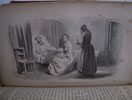
click on image to enlarge

Antiquarian category
ref number:
11009 